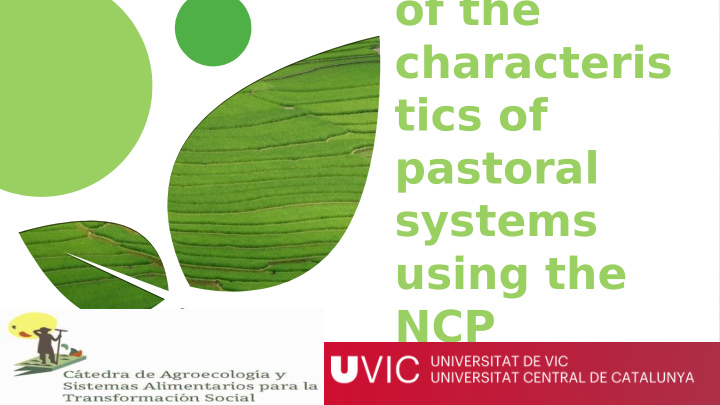



of the characteris tics of pastoral systems using the NCP classifjcatio
Pastoral systems have existed for thousands of years (1)
There are an estimated 200 – 500 million pastoralists in the world today (2) Why?
Highly effjcient form of natural resource and land management (3)
Pastoralism is characterised by ⊷Mobility ⊷Adaptability
More than just a form of production ⊷Social Cohesion ⊷Cultural activities ⊷T raditional ecological knowledge (TEK) (1)
Pastoralism – More than just a form of production ⊷Defjning role in landscape creation ⊷History of innovation ⊷Poorly understood
Pastoralism – More than just a form of production ⊷Pastoral systems have been increasingly abandoned or marginalised (5)
Aim of the study ⊷Reframing the ES literature through a nature’s contribution to people’s (NCP’s) lens ⊷How the literature has addressed linkages between NCP’s and pastoralism
Meta-analysis : Methods ⊷An analysis of the relationship between pastoralism and NCP’s was missing in the literature ⊷NCP’s are the evolution of the ecosystem services framework (6)
Meta-analysis : Methods ⊷ A search string was created: past* OR graz* OR agri OR extens* OR semi- natural OR grasslands AND livestock AND ecosystem-services OR environmental-services OR socio-eco* OR ltk OR tek AND NOT intensive
Meta-analysis :Preliminary Results ⊷ 608 peer review articles written in English ⊷ 88 articles accepted from the original 608 ⊷ 6 more articles were then added after consulting relevant professionals in the fjeld ⊷ 94 articles in total were examined
Methodology – Inclusion Criteria ⊷ Original research only ⊷ System must be characterised by mobility ⊷ NCP must be identifjable in the article ⊷ Published before 2019
analysis :Preliminary Results ⊷ The articles were compared across 37 difgerent categories: Study country, area and climate, If pastoralism had been defjned, T raits of pastoralism, T ype of pastoralism studied, T ype of pastoral system, Main trend of pastoralism in the region, state of landownership, Main threats identifjed in the region to pastoralism, Is ofg-farm work discussed?, Is the role of women discussed?, T ypes of animals in the system, External drivers of pastoralism in the paper, Specialist product creation, Methodologies used, Is a defjnition of ecosystem services given?, What ecosystem services are discussed?, What NCP’s are discussed (18 sub-groups)?, Specifjc practises of pastoralists mentioned
⊷ Transtermitance and transhumance are the most common forms of pastoralism
ALL NCP TYPES REPRESENTED
Meta-analysis: Discussion ⊷ Confjrmed the importance of pastoralism in providing a wide array of NCP’s ⊷ Expanding the recognition of NCP framework at a global scale
Meta-analysis: Discussion ⊷ Over-representation of specifjc NCP’s in the literature should be addressed ⊷T ranshumance is under increasing pressure ⊷T ranstermitance can be seen as a change in governance
Meta-analysis : Conclusions ⊷Literature referring to the NCP’s framework in the context of pastoralism is quite narrow ⊷Insight into the practical use of the NCP’s as a way to establish a picture of the status of pastoralism at a global scale using available case studies
References ⊷ (1) Starrs, P . F . 2018. “T ranshumance as Antidote for Modern Sedentary Stock Raising.” Rangeland Ecology and Management 71(5): 592–602. https://doi.org/10.1016/j.rama.2018.04.011. ⊷ (2) Niamir-Fuller, M. 2016. “T owards Sustainability in the Extensive and Intensive Livestock Sectors.” Revue Scientifjque et T echnique de l’OIE 35(2):371–87. ⊷ (3) Fernández-Giménez, Maria E. 2015. “A Shepherd Has to Invent: Poetic Analysis of Social-Ecological Change in the Cultural Landscape of the Central Spanish Pyrenees.” Ecology and Society 20(4):29. ⊷ (4) Krätli, Saverio, and Nikolaus Schareika. 2010. “Living ofg Uncertainty: The Intelligent Animal Production of Dryland Pastoralists.” European Journal of Development Research 22(5): 605–22. http://dx.doi.org/10.1057/ejdr.2010.41. ⊷ (5) Ruefg, H., and I. Rahim. 2016. “Enhancing the Economic Viability of Pastoralism: The Need to Balance Interventions.” Revue Scientifjque et T echnique de l’OIE 35(2): 577–86. http://doc.oie.int:8080/dyn/portal/index.seam?page=alo& aloId=33844 .
Thank s! ANY QUESTIONS? You can fjnd me at ⊷ Graeme.dean@uvic.cat
Recommend
More recommend